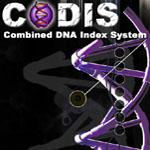 Yesterday,
we talked about how DNA complements crime-fighting
in new and powerful ways, thanks largely to an FBI
computer database called CODIS.
Yesterday,
we talked about how DNA complements crime-fighting
in new and powerful ways, thanks largely to an FBI
computer database called CODIS.
Now,
the rest of the story -- more on how CODIS works
and what it has accomplished.
How
is CODIS set up? CODIS is a three-tiered
system -- with separate local, state, and national
databases. That way, local and state labs can maintain
DNA databases according to their own laws and needs,
but still search for matches at the national level.
The national tier is called the National
DNA Index System, or NDIS,
and it is maintained by the FBI.
Where
do the DNA profiles in NDIS come from? The
overwhelming majority -- more than 1.5 million
-- come from convicted felons. Depending on the
state, the felons include those serving time for
rape, murder, crimes against children, robbery,
burglary, kidnapping, and assault and battery.
NDIS also includes more than 78,000 DNA samples
collected from crime scenes, more than 100 from
missing persons and another 300 from relatives
of missing persons, and some 150 from unidentified
human remains. DNA samples from suspected terrorists
are also collected today, but not uploaded to NDIS.
When you add it all up, there are more than 1.6
million DNA profiles in the national system.
Who
uses CODIS? A total of 175 crime labs
in all 50 states and Puerto Rico ... as well as
the FBI Lab and the U.S. Army Crime Lab. And, in
a sign of how effective the system is, 31 labs
in 18 nations worldwide also use CODIS, but they
are not connected to any DNA databases here in
the U.S. They simply borrow the FBI's technology
to help investigations in their own countries,
much as we do here.
How
is success measured? Mainly by keeping
tabs on the number of investigations helped by
CODIS through a hit or match that wouldn't have
otherwise been developed. In December, that total
passed the 10,000 threshold for the first time
(it currently stands at 10,770). We also measure "forensic
hits" -- when two or more DNA samples from
a crime scene are linked in local, state, or national
databases -- and "offender hits" -- when
one or more DNA profiles from a crime scene are
linked to a convicted felon. Since 1998, there
have been over 3,000 forensic hits and over 7,000
offender hits.
Success
stories? There are plenty. Check three
of them out below.
Thanks
to CODIS, the building blocks of life are often foundations
of law enforcement investigations. Science and technology
... truly making a difference in fighting crime.
Related
links: CODIS
website; success stories.


